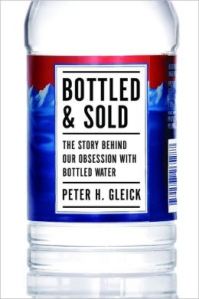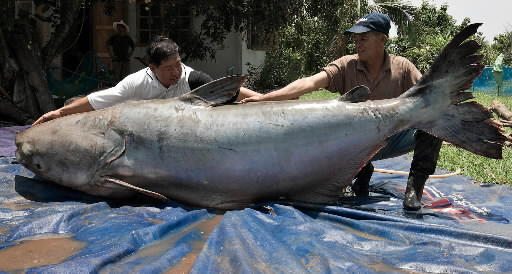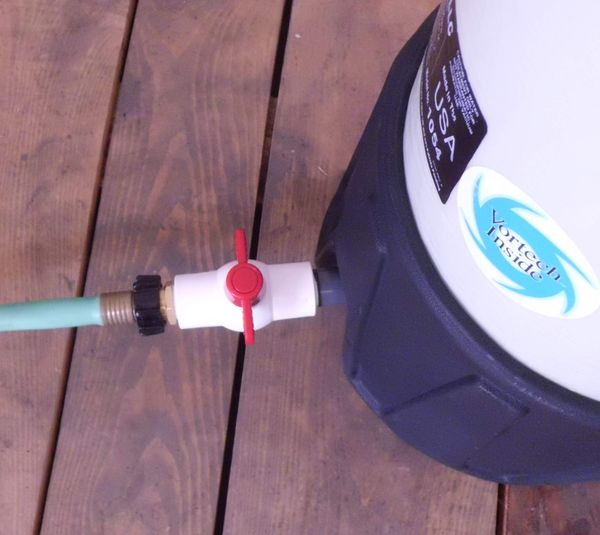In this pre-Independence Day Occasional, you'll hear about micro plastics in the Great Lakes, "cancer villages" in China, giant catfish in Laos, fracking studies at Duke University, and the teardown of an historic dam in California. Meet Tiger Tom, Peter Gleick, Bowser, Mal Warwick, and Pio Baroja. Hear loud and lengthy lamentations about dog droppings. Learn how to change the media in large water filters and how to drain the water out the filter or softener at your summer home. And, as always, there is much, much more.
The Pure Water Occasional is a weekly email magazine produced by Pure Water Products of Denton, Texas. We also publish the Pure Water Gazette, which puts up new articles about water and water treatment daily, providing “vast piles of information in the Gazette’s tangy, irreverent style” (Des Moines Register). We invite you to visit PureWaterProducts.com, the most information-packed commercial water treatment site on the worldwide web.
If you would like to read this issue on the Pure Water Gazette’s website, please go here.
While you were practicing your Fourth of July speech, a lot of interesting things happened in the ever-changing world of water. Read on to hear about some of them.
New from this week's Pure Water Gazette:
If Bowser Can't Control His Bowels, Let's Send Him to Mars, Where There Is No Water To Pollute
by Tiger Tom
Editor's Note: Veteran Gazette columnist Tiger Tom is no friend of dogs (see Tiger Tom’s Dog Products Page and Tiger Tom’s Tales of Dogs), and he gets extra steamy when he sees a pile of canine excrement on a lawn or sidewalk. Dog manure is not only an aesthetic nuisance; it is a major source of water pollution. Tiger Tom is dead serious when he tells us that Bowser may be cute to you, but to the rest of us he's just a smelly, expensive manure machine. --Hardly Waite.
A great environmentalist has said that the best thing an individual can do to help the planet is to serve his dog for dinner. That may sound radical, but the idea has merit. Dogs are without question the worst news possible for Planet Earth. These pampered gluttons consume vast amounts of resources, contribute nothing useful in return, and, worst of all, leave behind piles and piles of the foulest dung imaginable. And they are not at all particular about where they leave it.
Gazette numerical wizard B. Sharper has written at length on the damage done to water supplies by droppings by the world's far-too-numerous canines. Here are a couple of Bea's findings:
According to a Seattle study, the percentage of watershed pollution that can be attributed to dog wastes–20%.
Daily excrement output of these dogs, in tons–30.000.
Yearly excrement output of these dogs, in tons–10,000,000.
Number of 18-wheel tractor trailer trucks that would be required to haul away 10,000,000 tons of dog manure–267,500.
Length in miles of the caravan made by these 267,500 manure wagons if they were lined up bumper to bumper–3800.
Approximate percentage of Americans who don’t pick up their dogs’ feces–40%
It is about this last item, the irresponsible 40% who don't pick up after their slobbery mutt, that I want to speak. Forty percent is a lot of people, when you consider that 60% of American families now have at least one dog, and some have way more than one. An article in Stormwater suggested some ways to try to make the irresponsible responsible. Although the Stormwater article does not mention my own "serve your dog for dinner" remedy, here are a few of their ideas:
Turn Spot's Droppings into Something Useful.
From Massachusetts to the UK, dog waste is being converted into fuel to power everything from streetlights to homes. At Pacific Street Dog Park in Cambridge, Mass., a methane digester known as The Park Spark project transforms dog droppings into methane, which powers a lamppost. The park provides biodegradable bags to dog walkers, and encourages people to drop waste into the digester’s feeding tube. Across the pond in Chester, England, renewable energy company Streetklean is using a similar anaerobic digestion system to convert dog poo into energy that heats and powers residences.
DNA Testing.
It's not uncommon for cities or apartment complexes to fine people who leave dog waste behind, but some properties take clean-up duty more seriously than others. For example, Twin Ponds apartments in Nashua, N.H., is one of many properties that requires tenants with dogs to use a "PooPrints" pet DNA sampling kit when they move in. If feces is found on the grounds, property managers simply send the sample to BioPet Vet Labs, learn the dog's identity and fine the resident.
I, Tiger Tom, believe it would be entirely reasonable to require DNA samples from all dogs to be held in a national dog crap identification registry to be consulted any time an unidentified dog chunk is found in a public place. Here is a low tech variation on the same idea in which the public act as detectives to bust the irresponsible dog owner:
The small town of Brune, Spain, has reported a 70-percent decrease in dog waste since its campaign in which it returned dog poo to the rightful owner. For a one-week period, volunteers approached dog owners who left their pet’s droppings behind and struck up a conversation with the goal of learning the dog’s name. "With the name of the dog and the breed it was possible to identify the owner from the registered pet database held in the town hall," a spokesman from the council related. When the guilty dog owner’s address was confirmed, the poop was placed in a box labeled “Lost Property” and delivered via courier to the person’s home.
Similarly, the Blackburn City Council in England announced a program to publicly post the names and photos of people who don't clean up after their canine criminals. The city called on the public's help, asking residents to be the eyes of ears of the pilot program by snapping culprits' photos and reporting them to the council. The report does not mention if capital punishment was an option after identification of the mutt owner. Most of the schemes are way too nice. In Mexico City, dog owners get free WiFi for picking up after their mangy mastiff. "When people deposit bags of dog droppings into a special bin, it calculates the weight, and Internet portal Terra gives everyone in the park free minutes of WiFi. The greater the weight, the more time people have to surf the Web."
These, of course, are cutesy non-answers to a real problem. A steamy pile of dog dung isn't just a disgusting inconvenience: when it makes it into the water supply, it carries major bacteria and cysts. USA Today says that you can measure the canine population by measuring the fecal matter in the water:
From mutt to blue-blooded champion, all dogs harbor so-called coliform bacteria, which live in the gut. The group includes E. coli, a bacterium that can cause disease, and fecal coliform bacteria, which spread through feces. Dogs also carry salmonella and giardia. Environmental officials use measurements of some of these bacteria as barometers of how much fecal matter has contaminated a body of water.
I, Tiger Tom, say that polluting the public water supply is an attack on the public. Dare I call it terrorism?
Source Reference : Stormwater
Bottled Water Is a Symptom of Deeper Issues in Our Society
The Consequences of America's Obsession with Bottled Water
In A Nutshell: Berkeley scientist Peter Gleick‘s new book, Bottled and Sold: The Story Behind Our Obsession with Bottled Water, examines bottled water as a symptom of broader social issues like the decline in quality of our public water supplies, our naive susceptibility to marketing, and our acceptance of the throw-away mentality. Americans now drink more bottled water than milk or beer, and tap water is rapidly losing ground as the water of choice. The review below is excerpted from Mal Warwick’s Blog on Books.
Put down that bottle of water, please, take a deep breath, and listen up. It’ll only take a few minutes, and when I’m done, you may never pick up a bottle of water again.
“Bottled water? This is a problem?” Yes, to Berkeley scientist Peter Gleick, co-founder and president of the world-renowned Pacific Institute, “bottled water is a symptom of a larger set of issues: the long-term decay of our public water systems, inequitable access to safe water around the world, our susceptibility to advertising and marketing, and a society trained from birth to buy, consume, and throw away. . . Suburban shoppers in America lug cases of plastic water bottle from the grocery store back to homes supplied with unlimited piped potable water in a sad and unintentional parody of the labor of girls and women in Africa, who spend countless backbreaking hours carrying containers of filthy water from distant contaminated sources to homes with no water at all.”
 Bottling water on a large scale is a relatively new phenomenon. “In the late 1970s,” Gleick writes, “around 350 million gallons of bottled water were sold in the United States — almost entirely sparkling mineral water and large bottles to supply office water coolers. . . In 2008, nearly 9 billion gallons of bottled water were packaged and sold in the United States and five times this amount was sold around the world.” That’s a 25-fold increase in three decades, and “Americans now drink more bottled water than milk or beer.” (Betcha didn’t know that, did you? I sure didn’t!) Now, “data on beverage consumption reveals that on average, each of us is actually drinking around 36 gallons per year less tap water.”
Bottling water on a large scale is a relatively new phenomenon. “In the late 1970s,” Gleick writes, “around 350 million gallons of bottled water were sold in the United States — almost entirely sparkling mineral water and large bottles to supply office water coolers. . . In 2008, nearly 9 billion gallons of bottled water were packaged and sold in the United States and five times this amount was sold around the world.” That’s a 25-fold increase in three decades, and “Americans now drink more bottled water than milk or beer.” (Betcha didn’t know that, did you? I sure didn’t!) Now, “data on beverage consumption reveals that on average, each of us is actually drinking around 36 gallons per year less tap water.”Gleick notes that “when we do actually look, we find evidence that there are potentially serious quality problems with bottled water. . . [However], [t]he system for testing and monitoring the quality of bottled water is so flawed that we simply have no comprehensive assessment of actual bottled water quality.”
So, why hasn’t somebody done something about this? It turns out that the FDA is the culprit. Bottled water falls within the FDA’s purview. Gleick cites a study by the Government Accountability Office to the effect that “while the FDA does very few actual inspections of water bottlers, the few they conducted between 2000 and 2008 found problems a remarkable 35 percent of the time. Even this warning sign led to ‘little enforcement action.’”
OK, maybe you feel bottled water tastes better than water from the tap. But you’re probably fooling yourself. As Gleick reports, “test after test shows the same things: people think they don’t like tap water, but they do. Or they think they can distinguish the taste of their favorite bottled water, but they can’t.” Just check out “bottled water taste test” on YouTube, if you don’t believe this.
Here, then, are the Top Ten Reasons Not to Drink Bottled Water:
10. Tap water is free, and bottled water isn’t.
9. The quality of tap water is rigorously regulated, and bottled water’s isn’t.
8. Discarded plastic water bottles end up in landfills or on roadsides by the billions. For example, “Berkeley (population 114,000) sends around six tons of PET [the plastic used in water bottles] a week to plastics recyclers — much of it used water bottles.”
7. Large scale water-bottlers sometimes drain aquifers and cause wells to run dry in communities where their plants are located.
6. Large corporations such as Nestle (Pure Life), Coca-Cola (Dasani), and PepsiCo (Aquafina) own the major bottled water brands and suck in massive profits, making them even larger.
5. Most bottled waters are marketed in a misleading way. For examples, “Yosemite” brand water is actually municipal tap water from Los Angeles.
4. “Making the plastic for a liter bottle of water actually takes three or four more liters of water itself.”
3. If you live in California “and buy Fiji Water, the energy cost of transporting the water to you is equal to the energy embodied in the plastic bottle itself.” If it’s Evian water instead, the energy expended is even greater.
2. The total energy cost of bottled water, including the materials used, the production process, and the transportation, “is a thousand times larger than the energy required to procure, process, treat, and deliver tap water.”
1. Smart restaurateurs like Alice Waters are starting to ban bottled water on their tables. And who are you going to believe if you won’t believe Alice?
Source: Mal Warwick’s Blog on Books
Water News
The Giant Catfish--more than 600 pounds and 10 feet long--belongs to the shark catfish family. The Brobdingnagian fish has dwindled in number and is being protected by laws that ban fishing it, but its existence is now being threatened by Laos’s controversial Xayaburi Dam. Full story
Oregon onion growers are complaining that tough new federal water standards for irrigation water could put them out of business. Full Story.
It is only 33 days until National Garden Hose Day. Full story.
More than 200 villagers have died from cancer in the past 10 years in a village near a heavily polluted river in eastern Anhui Province of China. The once clear river that serves the village has turned black from industrial pollution. The village, with a population of just 1,000, is one of a number of so-called "cancer villages" near the Huaihe River and its tributaries. Full Story.
The Natural Resources Defense Council posts a map of US beaches that rates beaches on pollution and safety issues.
Lakes Huron, Superior and Erie are being overrun by small plastic beads known as a micro plastic. The small plastic beads, pictured on the penny above, are used by cosmetics manufacturers as abrasives in facial and body scrubs. They are too tiny for municipal water treatment plants to filter out and they wash down the drain and into lakes. Full Story.
New articles from the Pure Water Gazette:
Although the EPA is attempting to discover if fracking contaminates groundwater, it won’t have an answer for several years. In the meantime, study after study, plus tons of ”anecdotal evidence,” show that fracking pollutes wells. Here from Duke University is yet another strong piece of research that establishes fracking’s link to ruined wells.
Home tank-style water filters, either backwashing filters or simple “in/out” units that do not backwash, are essentially trouble-free performers, but eventually, the filter medium inside the tank has to be removed and replaced. Removal is usually the hard part of the job.
The Largest Dam Removal in California History Begins: Tearing Down the Historic San Clemente Dam
Introductory Note: The dam is a perfect example of the many things in our lives that are “mixed blessings.” For that reason, dams are always controversial. In one of my favorite novels, Paradox, Rey by Pio Baroja, progressive Europeans bent on saving the world go to Africa to build a dam. Among people and animals there are mixed reactions. The dam helps some and hurts others: the frogs love it, but the snakes hate it; poor people who get cheap electricity love it, but poor people who lose their homes hate it. The dam provides water for irrigation, but it covers up much valuable farmland. It provides water for cities, but it forces abandonment of other cities. It helps one species of fish but hastens extinction of another.
If we are allowed to generalize, we can say that dams are mainly an advantage to the rich and a burden for the poor. But there are exceptions even to that.
Dams are not permanent. They eventually die, choked by the sediment they have collected, and have to be removed. They are an advantage to the generations that benefit from their use but often a burden to the generations that pay for building them and tearing them down.
This month, June of 2013, the official tear down of the historic San Clemente Dam in California begins. The article below is from Water Efficiency Magazine.–Gene Franks.
Bottom Drain Backwashing Filters Are Ideal for Summer Homes, Hunting Cabins, and Other Locations Where Tanks Must Be Drained For Winter
Pure Water Products’ 5600 Series of residential-sized backwashing filters are now available with a bottom drain feature that allows easy draining of the filter without removing the control valve. This feature is especially valuable for those who need to drain the water from filters that are not used in winter.
Tank comes with a convenient garden hose fitting so that drain water can be directed outdoors or to a drain.
With this filter the tank can be drained completely and quickly without the need even to disconnect it from plumbing. The tank setup includes a bottom grid installed inside the tank to hold the media so it will not leave the tank as the tank is drained, a valve to release water from the tank, a garden hose connection so that the drained water can be directed to a drain or outdoors, and a vacuum release port to allow water to leave the tank. The vacuum port can also be used to replenish media in neutralizing filters without removing the filter’s control valve.
The tank can be supplied with any standard filter style, such as carbon, catalytic carbon, birm, calcite, Filter Ag, ChemSorb (Micro Z), or multi-media. It is available only in the basic 10" x 54" size.
More Information: Pure Water Products, 940 382 3814.
The only thing better than a garden hose is a garden hose with a filter. Don't be caught without a garden hose filter on National Garden Hose Day.
Thank you for reading, and please stay tuned next Monday for another wisdom-packed Occasional.
Places to Visit on Our Websites
Model 77: “The World’s Greatest $77 Water Filter
”Sprite Shower Filters: You’ll Sing Better!
Write to the Gazette or the Occasional: pwp@purewaterproducts.com
Please Visit
The Pure Water Gazette – now in an easier to navigate format.
![occasionalbanner300[1]](https://ymlp.com/https.php?id=purewatergazette.net/blog/wp-content/uploads/2013/04/occasionalbanner3001.gif)

![tiger[1]](https://ymlp.com/https.php?id=purewatergazette.net/blog/wp-content/uploads/2012/04/tiger11.gif)



